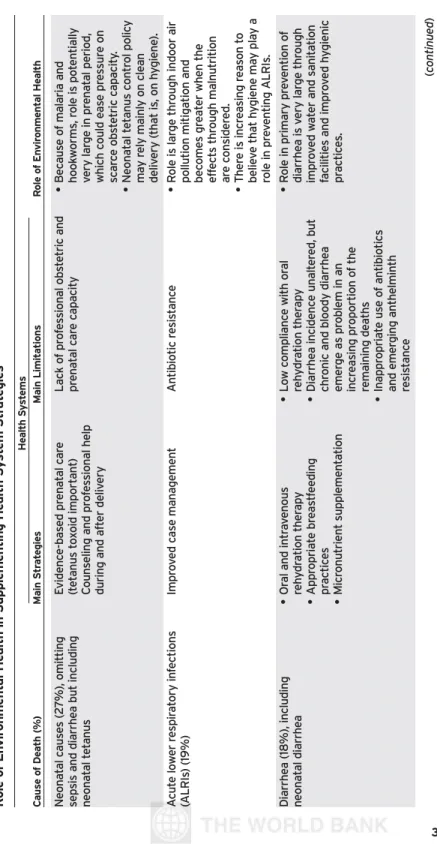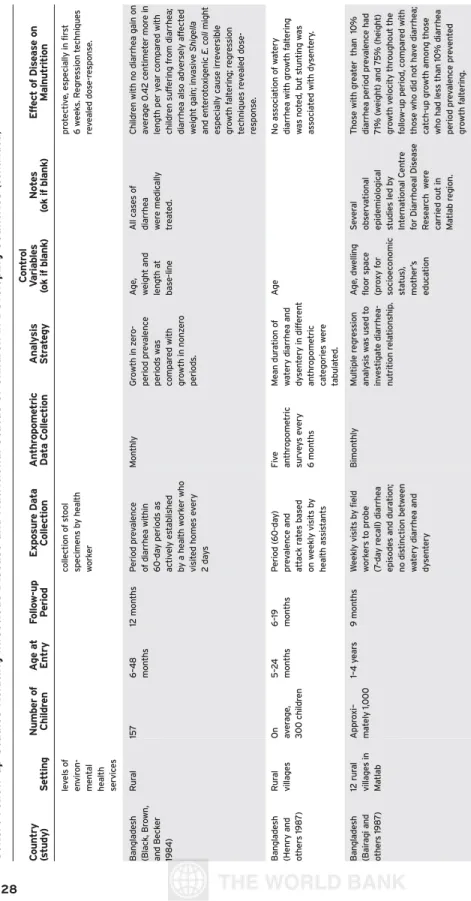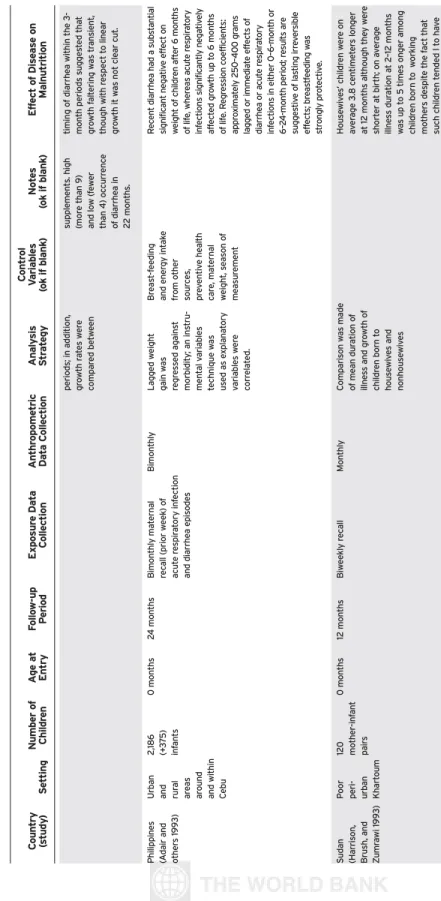3 1.1 Millennium Development Goals and environmental health 10 1.2 Annual costs of direct and indirect impact on the environment. This book is a product of the Environmental Health Anchor Program of the World Bank's Environment Department.
Introduction
In addition, the study discusses the role of environmental health inputs in child survival and growth. To analyze new data on the environmental health burden of disease (at sub-regional level) relating to children under five years of age.
Epidemiology
This chapter revisits the links between malnutrition and environment-related infections and attempts to demonstrate the importance of environmental health for child survival and growth. A review of past and recent research is presented that points to the importance of repeated episodes of disease (such as diarrhea and malaria) in the development of malnutrition (see Appendix A for a more detailed analysis).
Environmental Health,
In addition, childhood malnutrition is associated with disease, poor mental development and reduced learning ability (Alderman and others 2006). Because research and mainstream debate have revolved around how malnourished children are more susceptible to infectious diseases—including diarrhea and acute respiratory infection (ARI)—the links between environmental risk factors and malnutrition are less recognized.
Malnutrition, and Child Health
While the effect of malnutrition on disease is widely recognized, the role of infections in the deterioration of nutritional status has been relatively neglected. In the life cycle of a child, the period from the womb to the age of about two years is the so-called window of opportunity.
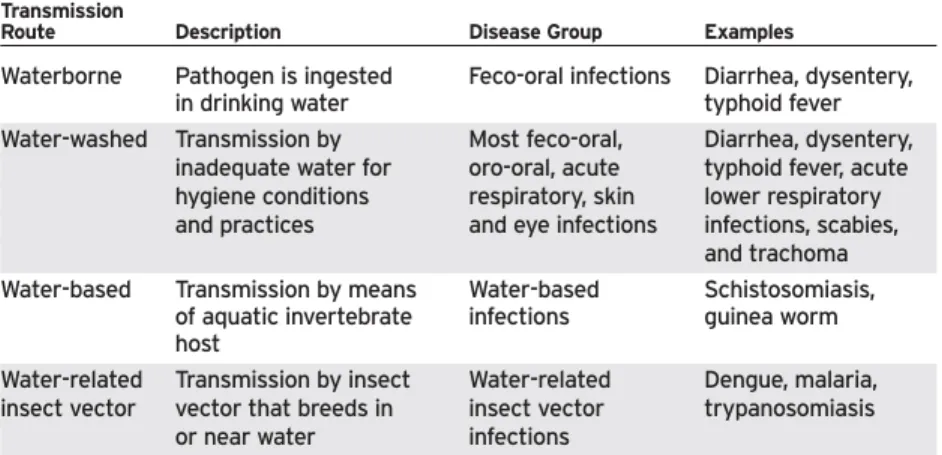
How Environmental Health Supplements Other Child
From the health sector's perspective, primary prevention involves vaccinations, micronutrient supplementation, promotion of breastfeeding, and measures to reduce low birth weight, including birth spacing (Murphy, Stanton and Galbraith 1997) (see figure 3.1). Additional activities related to environmental health (sanitation, clean water and vector control) are largely ignored because they fall outside the current health sector mandate (see figure 3.1), even though environmental health legislation is often in place and such activities are known. to be extremely efficient.
Survival Strategies
However, some areas where case management through health systems is not sufficient – in the case of childhood diseases such as diarrhoea, acute respiratory infections and helminth infections, for example – require better primary prevention of environmental risks (see Table 3.1 for describing how environmental health can complement health sector activities). Additional environmental health interventions, such as the provision of clean water and sanitation, play a complementary—but important—role in these health promotion efforts.
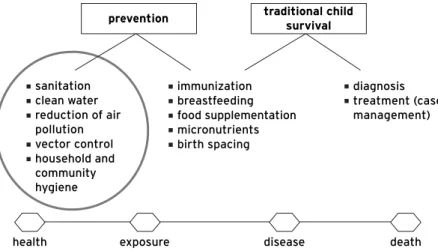
Economics
What is the environmental impact on children under five, taking into account the links with malnutrition. Answering these questions will help policymakers understand the magnitude of the environmental health burden and better integrate environmental health into decision making for economic development.
How Large Is the Environmental Health Burden?
Percent? Supporting Evidence from Recent Cohort Studies
Results from the latest WHO analysis (Fewtrell and others 2007) show the water-related (WSH and water resource management, or WRM) environmental health burden for children under five in different sub-regions (see Figure 4.2). From a child health perspective, three sub-regions of sub-Saharan Africa and South Asia stand out in terms of the environmental health burden of disease. Although current methods for estimating environmental health attributable burdens use the best available information, the effects of environmental risk factors are significantly underestimated for several reasons.
Studies of the costs of environmental health effects are mostly based on quantification and valuation of disease-specific mortality and morbidity caused by environmental risk factors.
Estimating the Environmental Health Burden and Costs at the
IN PART I, new results from the World Health Organization (WHO) on the environmental health burden of disease were presented and the findings discussed (Fewtrell and others 2007). These new estimates take into account the effects of environmental risk factors (including their effects on malnutrition). Using case studies from Ghana and Pakistan, previous estimates are updated by accounting for the effects of environmental hazards (including impacts from malnutrition) and attempting to estimate impacts on cognition and learning and on future labor productivity and income. (see appendix D for a detailed methodology).
The World Bank has made extensive use of valuation techniques to measure the costs of environmental degradation at the country level.
Country Level
Previous studies have reported the costs of environmental health impacts in Ghana (Larsen 2006) and the costs of environmental degradation in Pakistan (Krupnick, Larsen, and Strukova 2006). Health effects of malnutrition. The fractions attributable to malnutrition for various diseases have been calculated for Ghana and Pakistan (see Table 5.4) based on estimates of increased risk of cause-specific and all-cause mortality in children below five years of age with different levels of malnutrition. For Ghana, previous environmental cost estimates put it at 370 million (US$412 million), equivalent to 3.8 percent of the country's GDP.6.
Source: Compiled by World Bank team. the effect), as well as the timing of these effects, this study hopes to influence the way governments choose between short-term and long-term interventions.
Experiences
THE PREVIOUS CHAPTER PROVIDES EVIDENCE of the importance of environmental health interventions in addressing children's health. Using two country examples—Ghana and Pakistan—chapter 5 then analyzed the subsequent economic burden these environmental health risks pose. What remains is the "how": how can these environmental health issues be successfully addressed in developing countries.
This chapter begins with a historical overview of environmental health, outlining trends in environmental development.
Approaches to Environmental Health
In the early 20th century, much of the environmental health work focused on rural sanitation (Berg 2005). Numerous other factors compound this relative neglect of the environmental health agenda in developing countries. Environmental health has been detached from the mainstream agendas of health agencies (which now focus more on a case management perspective) and newly formed environmental protection agencies (which focus more on environmental regulation and compliance) (Kotchian 1997).
Similar changes are occurring in the donor community with a growing recognition of the critical role of environmental health.
Conclusion
A growing body of evidence points to the need to integrate environmental health interventions into child survival strategies in developing countries. In many ways, this report represents a first step toward providing policymakers with epidemiological, economic, and empirical evidence for integrating environmental health into the child survival agenda. In addition to conducting economic analyses, governments in developing countries must focus on implementing specific measures for environmental health.
Therefore, scaling up preventive environmental health interventions (such as clean water and sanitation) to reduce the current burden of disease is a prudent investment (Campbell-Lendrum, Corvalán, and Neira 2007).
Technical Review of Cohort Studies
Another reason for difficulties in attributing growth faltering to infections lies in the methodology for research studies. This reduces the ability of investigators to find the effects of infections on growth (Checkley and others 2003; see also the discussion of early infancy in chapter 2). Enteric infections cause growth faltering in children in developing countries, even in the absence of diarrhea.
Home visits 2 or 3 times per week to determine the prevalence of clinical diarrhea and stool samples to determine enteric pathogens, eggs, and parasites.
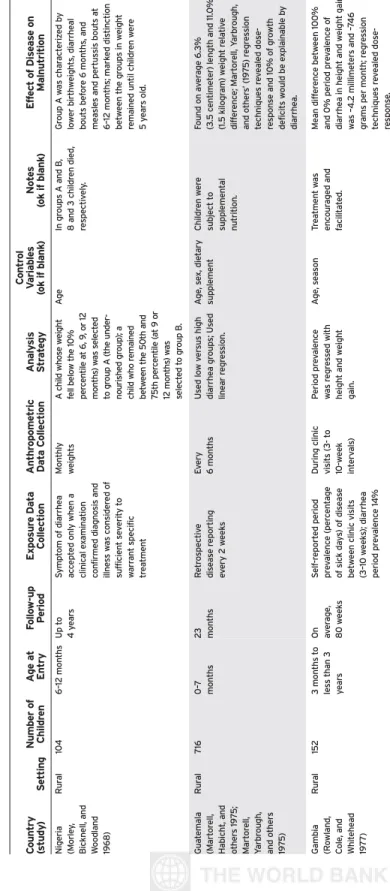
Review of Studies on Nutritional Status and Education
They find that stunting (HAZ < –2) in early childhood is associated with a loss of 0.9 years of grade attainment at age 18. Alderman and others (2001), using longitudinal data on 560 children in rural Zimbabwe, find that a decrease in HAZ of 1 is associated with a loss of 0.68 years of grade attainment and 0.4 years of delayed primary school enrollment. They find that the effect on test scores of a change in HAZ of 1 corresponds to 0.8 years of schooling, and for the more severely stunted children (HAZ < –2.5) it corresponds to 1.8 years of schooling.
They note a delay of 0.7 months in registration per diarrheal episode in the first two years of life.
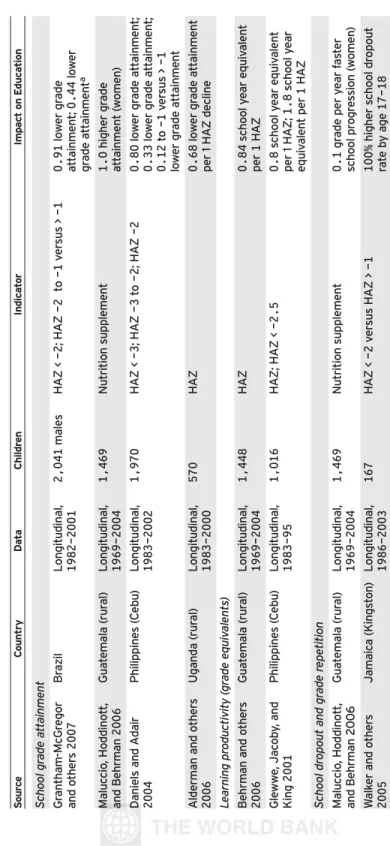
New Estimates for Burden of Disease from Water, Sanitation,
The study included the effects (due to malnutrition) of water, sanitation and hygiene on mortality and burden of disease.
Burden of disease (in DALYs) in children under five attributable to water, sanitation and hygiene, by World Health Organization subregions, 2002. THIS APPENDIX PROVIDES A DESCRIPTION OF THE METHODS used to estimate the environmental health burden of disease, including the effects on education - tion, and relative monetary costs.1 An overview of the results for Ghana and Pakistan is provided in chapter 5. The first involves the valuation of deaths for each cause of death (left side of figure D.1), and the second relates to the estimation of educational costs of illness (right side of figure D.1).
This section details the steps used to estimate mortality from environmental health risks (figure D.1, steps 1 to 6).
Computing Country-Level Environmental Health Burden of
The environmentally attributable disease in Ghana is estimated with reference to diarrhoea, acute lower respiratory infections (ALRI), malaria, measles, protein-energy malnutrition and a remaining group of other causes of death (table D.1). It is important to note that diarrhea is both a cause of death and a risk factor through its effect on malnutrition and resulting deaths. Deaths related to urban air pollution are not included because of the small effect on child mortality that can be calculated from current estimation methods.
Disease
The next step is to estimate the population in each exposure category in the absence of environmental risk factors. The fraction of cause-specific deaths attributable to environmental risk factors (for example, the fraction of ALRI mortality attributable to indoor air pollution and diarrhea-related malnutrition) is obtained by combining in equation D.2 the parameters obtained in steps 2 and 3. This method—the human capital approach—is often considered to provide a lower estimate of the value of mortality avoidance (see appendix F).
Prevalence rates in absence Prevalence of stunting Height-for-age rates (malnutrition) in 2003 (%) due to infectious diarrhea.
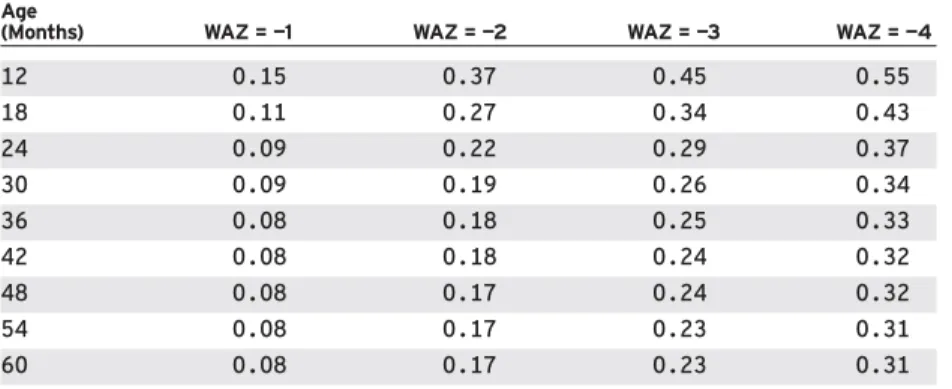
Monetary Valuation of the Cost of Environmental
The World Health Organization's methodology for estimating the burden of disease is a powerful tool for decision makers. Knowing the burden of disease makes it possible to compare policy options that act on different causes of death and have different mortality and morbidity impacts. A major advantage of using burden of disease is that it does not require a monetary valuation of the benefits of an intervention (for example, there is no need to know the value of a life).
Monetary valuation has also been widely used to express the burden of disease in a metric that is easily understood by policymakers without a public health background.
Health Risks
Traditionally, the valuation of health damage has been based on the calculation of the perceived costs caused by death or illness. An important limitation to the application of the WTP approach is in relation to children's lives. A longitudinal study of the impact of behavior change intervention on cleanliness, diarrheal morbidity and growth of children in rural Bangladesh.” Social Science and Medicine.
A Comparative Study of Rotavirus Epidemiology in Children from Community and Hospital Birth Groups in South India.” Journal of Clinical Microbiology.
